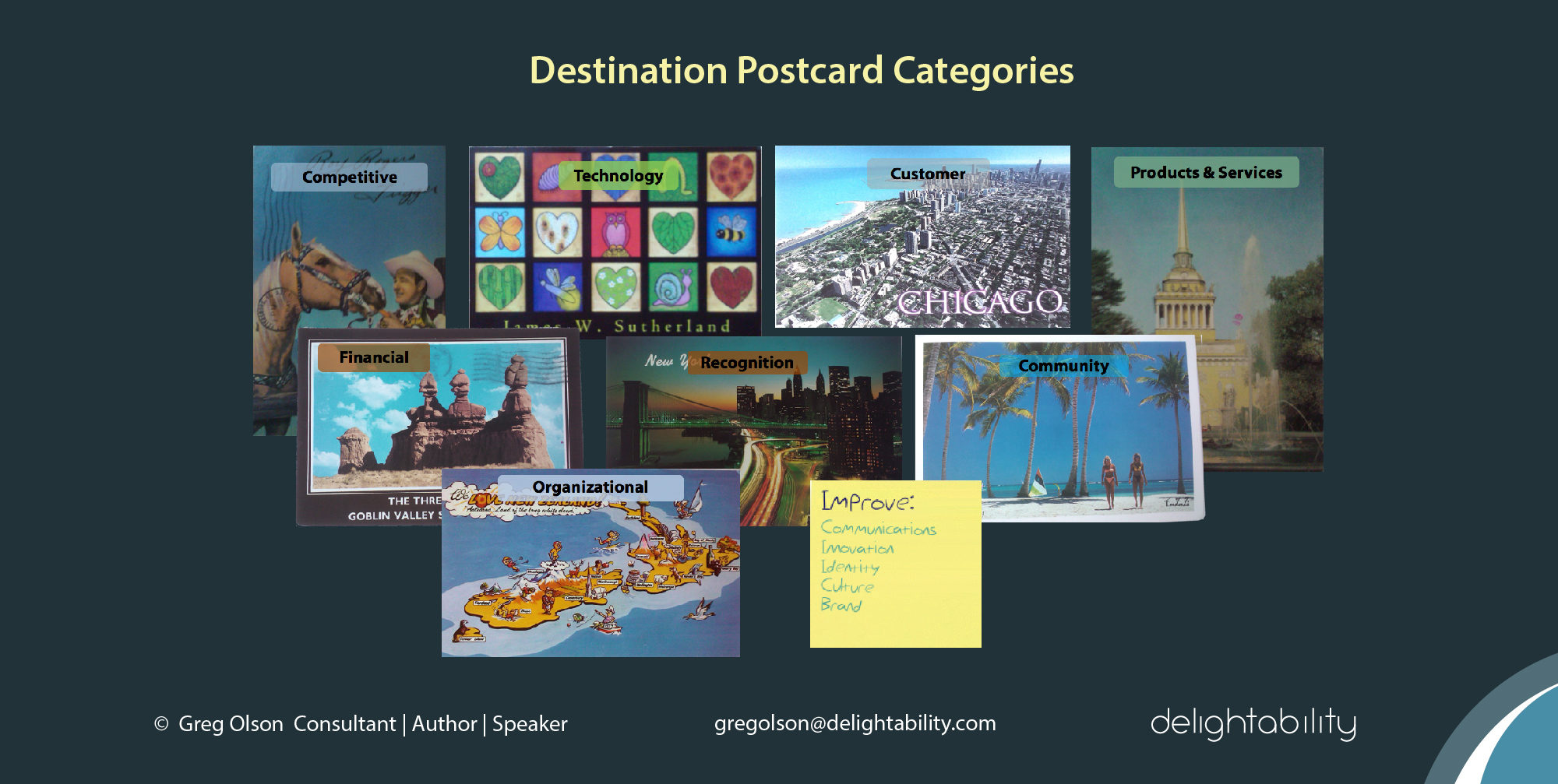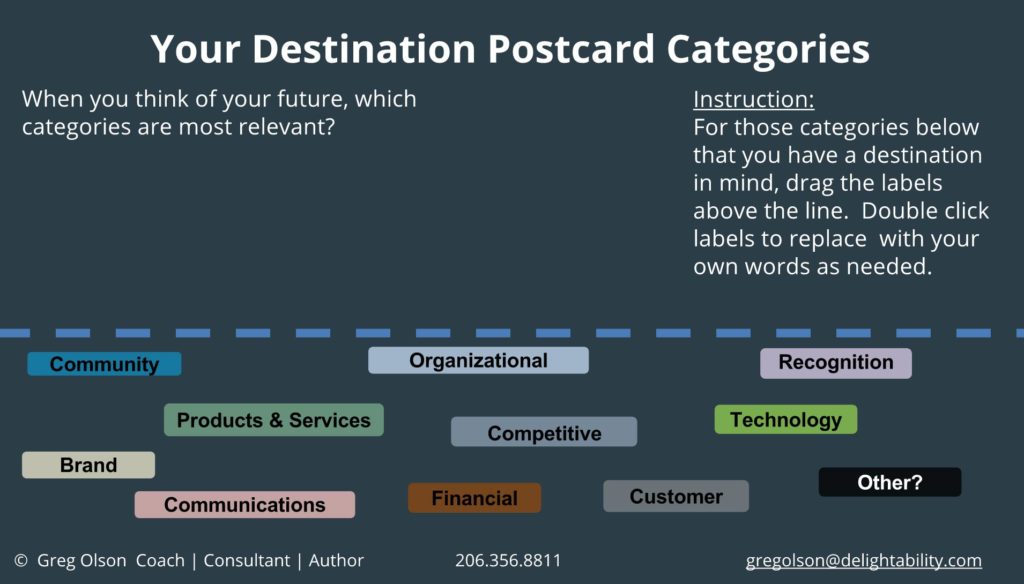Home » Freebies » Use Destination Postcards to Discuss the Future
Have a Better Discussion About the Future
Destination Postcards give people the ability to get on the same page about the future of the organization. The Destination Postcards visioning exercise can be done on your own or with a team. It is helpful to have the assistance of a facilitator or business coach, but you can do this exercise on your own.
"If you don’t know where you are going, any path will take you there.” – Sioux Proverbs
What Exactly is a Destination Postcard?
- A Destination Postcard is a mental model that represents a vivid picture of the future you'd like to realize
- Destination Postcards are organized by category and can be about any subject
- Destination Postcards can help you tell better stories about the future
- Don’t worry about how to get to the destination, that’s another exercise
4 Steps: Getting Clear on the Organization's Future
- Envision Great Possibilities
- Prioritize Destination Postcard Categories
- Make a Statement About How the Future Will Feel
- Empower Good Storytelling
Step 1: Envision Great Possibilities
The first step in the Destination Postcards exercise is to actually decide where you want to go. Every business, non-profit, and governmental organization has multiple destinations; these are the Destination Postcard categories. The list that follows is not exhaustive. Choose the categories most important to the future of your organization. It might be that all of them are important or maybe 2 or 3 are most important in the next year. Be creative and be aware of blind spots while choosing. Consider affinity mapping to generate more ideas for categories or validate those selected.
Categories for Creating Destination Postcards:
- Technology
- Organizational
- Financial
- Customer
- Brand
- Communications
- Community
- Competitive
- Products and Services
- Recognition
- Other?
Step 2: Prioritize Destination Postcard Categories
When you think of your organization's future, which postcard categories are most relevant? A straightforward method to prioritize the categories is to note which categories are above the line (important) or below the line (not as important at this moment). If you are doing this exercise with a team consider having each person select categories on their own; then compare.
What if Our Team Doesn't Agree?
It's perfectly natural to have some differences when viewing the future. If your team is having difficulty agreeing on postcard categories consider another method that is useful for gauging the level of disagreement. Have each person rank each category on whether it is a MD (must do), SD (should do), or CD (could do) item for the organization. An alternative is to time phase each destination and gain agreement on when each category will be addressed in the future. Use these methods and you'll be able to reconcile seemingly incompatible views.
Step 3: Make a Statement About How the Future Will Feel
By establishing the categories that are most important to the organization, you’ve appealed to the rationale mind (the rider). In Switch vernacular, you’ve directed the rider by pointing to the destination. This is necessary, but not sufficient. Next, you’ll want to appeal to the emotional elephant; you’ll not reach your destination without getting your emotional elephant on the path.
How to Appeal to Your Emotional Elephant
Your emotional elephant is more motivated once it "finds the feeling." Imagine what it must be like once you've arrived at your desired future state. You're living the dream, baby! What's that feel like? How will you know you’ve arrived? What will you see as different and how will that make you feel? Write a statement or add bullets to show some detail about this desired future state and how wonderful it feels once you've arrived.
An Example Destination Postcard
Here is an example using the Destination Postcard category, recognition. Once we’ve arrived at the destination we might feel the following:
- Feel confident in applying for the “most green citizen” award
- Media and partners are recognizing our work
- Awards and framed articles hang on the trophy wall in the lobby
- Our products are labeled with the Cradle to Cradle Certification
- We have more twitter followers than Edward Snowden
Step 4: Empower Good Storytelling
By now, you’ve began crafting a narrative for the organization’s future. You have made some choices about what is most important to the organization's future. You've also remarked on what it will feel like once you get there.
Going through a Destination Postcards exercise will unlock clarity that was previously trapped. If you do this exercise with colleagues, you’ll be better aligned to a common future. You can reference the Destination Postcards as you build your strategic plan and tell stories about the future. Once the future becomes the past you can add your postcards to your trophy wall and create a fresh batch for the next phase. Yes, I do mean actually create physical Destination Postcards.
BONUS: Create Physical Two-Sided Destination Postcards
What happens to the people who were not in the room for the exercise? Maybe they couldn't be because they haven't yet been hired. Or, perhaps the audience are channel partners or reps who have yet to be on-boarded to this shared future. You are thinking of sharing the postcards at the kickoff meeting, right? These are situations where it can be helpful to produce physical Destination Postcards. Your organization might have a dozen of these in their strategic deck. Or you might get even more granular for product lines or business units.
On side 1 show an inspirational image that reinforces the category. On side 2 go into a bit more detail. Consider using a measurement slider that shows the current state and where you'd like to move within that category. Along the left side add bullets to show past accomplishments. To the right show future programs or initiatives that will help increase performance within that particular category.
Physical postcards empower good storytelling. They can be seen, touched, passed around, referenced and refreshed as needed. See the related article, Choose Wisely, about using business performance continuums to assess the current and future state of the organization across nine common dimensions.
See also Make Work Feel Like a Vacation
Discuss Projects
Ready to discuss your needs?



